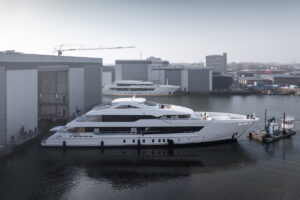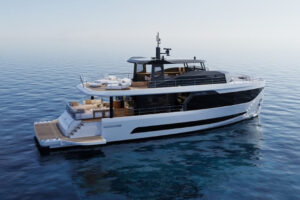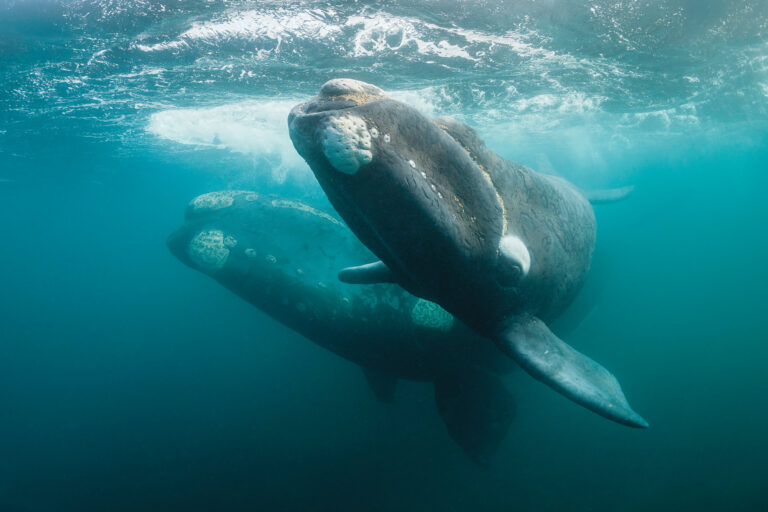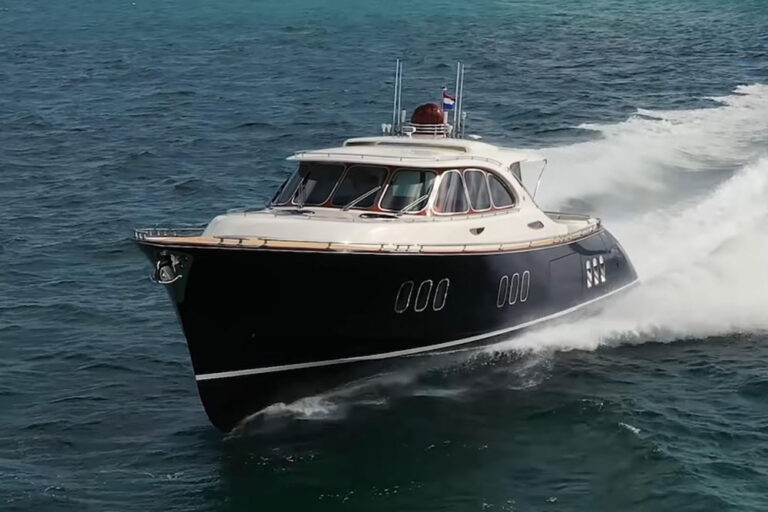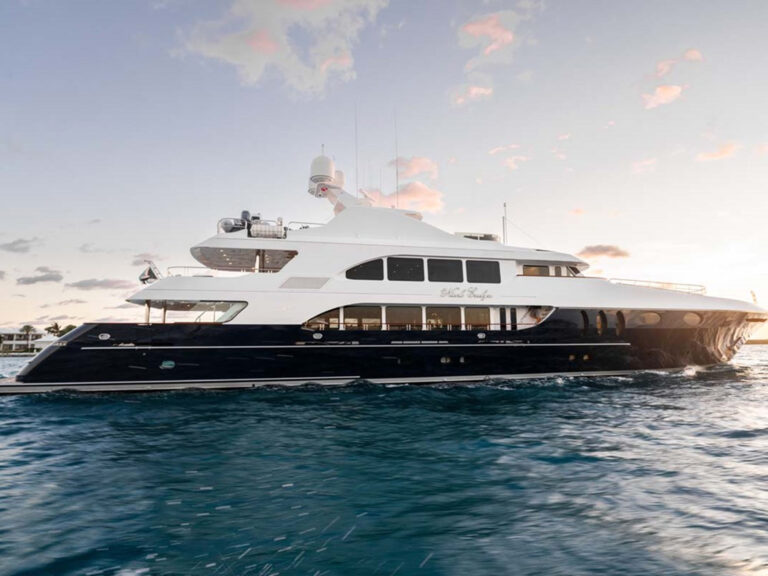Alithia is her owner’s first-ever boat, commissioned by the young German businessman for an extended world cruise with his wife and children. His goal was to create a hands-on learning adventure for the entire family. Every detail aboard the 130-foot yacht reflects this purpose, and the owner’s take on life.
“Everything superfluous has to go, the owner wrote for the yacht’s Web site. Translated from its Greek origins, the name Alithia means truth, or truthful one. “And it is true, the owner continues. “We discover more is less; simplicity fuses function and form, performance, and aesthetics. Designed by Bill Tripp and built of lightweight Alustar aluminum by Abeking & Rasmussen, Alithia is an open book of remarkable visual simplicity, but an equally remarkable complexity lurks beneath the surface.
A face-to-face encounter with Alithia is like squaring off against Xena, the warrior princess. She’s lovely all right, but you don’t want to make her angry. This first impression comes from the severity of Alithia‘s bow. It reminds me of the business end of a chisel, made beautiful by a softening hollow at the waterline and a bit of flare above. The knuckle at the base of the plumb stem lightly kisses the water when Alithia rests quietly at her mooring, as she was when I caught up with her in Antigua. When she stretches her legs for a top-speed reach, the knuckle lifts clear of the surface like the chin of a sprinter at full stride.
Unlike a lot of modern yachts, which seem to be designed from the inside out, Alithia‘s form emerged from the owner’s request for speed. Her appearance flaunts her race-boat genes. Critics of race-boat themes applied to cruising yachts may argue that her vertical stem is an affectation and contrary to the short but lovely counter stern. These two design elements often stumble over each other, but Tripp made them work as a team on Alithia. In addition to its purposeful good looks, this yacht’s vertical stem extends the waterlines, therefore top speed.
Opponents of the vertical bow like to argue that it may cause the bow to root, creating unpleasant steering characteristics-the bow steering its own course regardless of what the rudder does. I’ve experienced this bow steering, but on a poorly executed and unbalanced hull. Alithia‘s bow, though, has the sense to chisel through the surface chop and lift over the swells, upwind or down, because her hull gains buoyancy fairy quickly.
At about 40 degrees to the apparent wind, leeward rail kissing the sea, Alithia heeled a little then accelerated like a boat half her size. Skipper Graham Pearson trimmed sail while I steered, and we pushed Alithia to 13 knots in about 23 to 25 knots of true wind.
The Rondal captive hydraulic winches start slowly and build speed as they wind on more trim. This is fine for cruising, but most annoying when you’re short-tacking out of a harbor. Although Alithia is very quick in stays, the dreadfully slow winches delay optimum trim for the new tack.
Off the wind, she balanced on her powerful elliptical sections and symmetrical waterlines. Her relatively shallow canoe body and carefully distributed volume reduce wave-making resistance to a minimum, so she didn’t dig a hole in the water amidships. On the delivery from the A&R yard running before a 50-knot wind under a triple-reefed main and the staysail, Alithia touched 19 knots. The owner should expect double-digit average speeds when the wind and seas cooperate. Although we experienced seas of only 4 to 6 feet, Alithia‘s extraordinarily seakindly motion in these conditions indicates she’ll be easy on her crew when the weather turns ugly.
The price an owner pays for visual simplicity is in intricate systems. All of Alithia‘s sail controls are hydraulic, involving eight captive-reel winches, rams and electronic command modules. In keeping with the minimalist theme, all of the running rigging passes through tunnels between the false deck (what you walk on and see) and the structural deck below. Hatches are flush with the teak deck, and the genoa tracks are on the caprails, further reducing clutter on deck.
Alithia‘s accommodations, too, are free of clutter-almost to the point of being sterile. When I sailed her, only a few very small paintings graced the bulkheads. Books were conspicuous by their absence, all of them being confined to a small room that serves as a library and medical facility. Recessed quartz fixtures in the overhead and the occasional table lamp brighten the accommodations at night and on cloudy days.
Andrew Winch designed the accommodations to the owner’s brief. In his quest for minimalism, the owner insisted on square corners nearly everywhere. I understand the effect he wanted, but I definitely wouldn’t want to fall against one of the corners. A headfirst tumble could be fatal.
On the other hand, the furniture and cabinetry are stunning. Everything that isn’t being used hides behind a closed door or electrically operated panel. A touch of a button at the nav station calls up two flat-screen displays for navigation and ship’s monitoring. A hinged desktop opens onto the instruments, and all of the communication devices are behind a closed door or inside a drawer. When you want to enter the head in the children’s stateroom back aft, simply step to the sliding door and it opens electrically. The main companionway hatch, too, opens and closes under power.
This starkly simple interior of light Canadian maple veneer over aluminum honeycomb coring shelters a maximum of 18 persons-mother and father, five children (two girls, three boys, ages 5 to 14), two teachers, and seven crew, two of whom are paramedics/security guards, plus two occasional guests.
The after stateroom is a dormitory for the children and has five berths plus one for a guest of the children’s choice. Like any good dorm room, it contains a large, comfortable worktable with a computer at each of the six work stations, and a large plasma-screen TV. The table lowers to form a berth. The children have their own laundry and head.
Satellite communications equipment provides high-speed access to the Internet for the children’s schoolwork, communication with friends and a tele-medicine network in case of a medical emergency. Medical records of every member of the crew, family and guests will be aboard. The mini-hospital opposite the galley has a well-stocked pharmacy, a supply of oxygen, a defibrillator, a stretcher, a video camera and access to a 64k video conferencing network that sends real-time pictures to a doctor ashore.
The master stateroom surprised me with its modest size and simplicity, showing the owners’ devotion to the comfort and enjoyment of their children while they are away from home. Opposite the master stateroom is a pair of small cabins and a common head for the teachers. Crew quarters and galley occupy the forward third of the interior. All told, Alithia has 18 berths and seven heads with a shower in each.
Living aboard a sailboat at sea may seem like purgatory to landlubbers, but a few minutes in Alithia‘s common areas belowdecks ought to open their minds. The upper and lower saloons feel positively palatial, lighted by acres of glass around the raised saloon and two large hatches in the overhead. Even at night, the light joinerwork and neutral fabrics will glow under the indirect lighting.
One of the design team’s goals was to create an exceptional view from the dining and lounge areas in the house-a feeling of being outside-and they’ve done this by extending the bottom of the windows to deck level.
Self-sufficiency adds to the pleasure and adventure of extended cruising, and Alithia has all the right stuff. She gets all the electricity she needs from two generators, one of which runs continuously to power the electro-hydraulic system. Her galley is large and has enough cold stowage to last for the longest passage the yacht likely will make. A watermaker keeps the tanks full.
I wonder if the owners need another crew member.
Contact: Abeking & Rasmussen, (011) 49 421 67 33-537; www.abeking.com. Tripp Design, (203) 838-2215; www.trippdesign.net.

